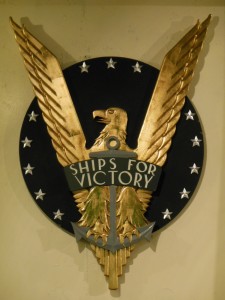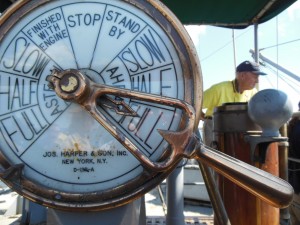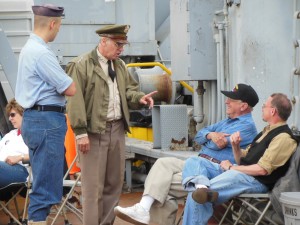Liberty ship John W. Brown hosts veterans, students for Memorial Day cruise
Question: What is the largest American-flagged passenger ship currently in operation on the east coast?
Most people would guess that it is one of the luxury liners which grace the Baltimore harbor, so they are surprised to learn it is the John W. Brown – a liberty ship constructed primarily for cargo service during World War II.
Liberty ships – those ungainly cargo transports of so many wartime newsreels – were originally designed to have a useful life of about five years. Hundreds survived the war and went on to aid a number of rebuilding nations, while others filled the fleets of entrepreneurs such as Stavros Niarchos and Aristotle Onasis. Today only two of the rugged warriors are still in operation: the Jeremiah O’Brien (based in San Francisco) and Baltimore’s John W. Brown.

The Brown was built in Baltimore at the Fairfield shipyard in 1942. Liberty ships were constructed at eighteen different shipyards along the Atlantic, Pacific and Gulf coasts. Fairfield had the greatest output of any shipbuilding operation during the war, employing some 47,000 men and women who worked ‘round the clock to produce an astounding 384 Liberty; 95 Victory; and 30 LST’s. After the war, the Brown was decommissioned and then spent the next 36 years on Manhattan’s East River as the only shipboard maritime high school in the United States.
Now a floating museum, the John W. Brown cruises from Baltimore to Annapolis several times a year. Last weekend the Brown hosted veterans, their families and friends, for the annual Memorial Day cruise. The day included remembrances, a wreath laying, and a thrilling demonstration by five vintage WWII era aircraft. Entertainment was provided by The Manhattan Dolls and by The Ultimate Abbott and Costello Show.
Charlestown resident William Fitzpatrick had a plum perch from which to see the lovely Manhattan Dolls. Fitzpatrick served as a Navy Seabee during WWII.
Fitzpatrick told the Baltimore Post-Examiner the Seabees were a construction unit conceived by the late Rear Admiral Ben Moreell who foresaw the need of enlisting skilled tradesmen for the quickly expanding war effort. Fitzpatrick said his service as a floater with CBMU – 593 took him to numerous places in the Pacific Theatre, including the construction of the airstrips on Tinian.

“It was a maturing period in my life,” observed Fitzpatrick. “I met some of the finest guys I have ever known.”
One of the guys Fitzpatrick met while serving in the Pacific was a Polish emigre named Thaddeus Glendowski.
Fitzpatrick said Glendowski was a rock-ribbed man who would go on to be a Navy boxing champion. But he struggled with his English – so much so that he asked Fitzpatrick to compose a love letter to a girl he adored back home.
“I wrote this beautiful letter for him, and when the girl wrote back, she said, ‘Why didn’t you tell me these things before you went away?’ They married after the war and settled in Pennsylvania.”
Philadelphia native Howard Dolan, Jr., a board member of the John W. Brown, said he first became interested in the ship after learning about it at the Mid-Atlantic Air Museum’s WWII Weekend.
“The nice thing about volunteering for this organization is you don’t need to have a background in the Navy or Merchant Marines. Anybody can join.”
The John W. Brown operates under a unique set of Coast Guard regulations. Though designed for cargo, it is currently used primarily as a passenger ship. All of the licensed seamen (officers, able-bodied seamen) on board have studied and completed the same kind of curriculum Merchant Marines would have taken seventy years ago. The ship must meet modern safety standards whenever passengers are on board, so both Coast Guard inspectors and the crew keep a weather eye out for potential problems.
Dolan said, “After sixty years as both a working classroom and a floating museum, we’ve developed a great relationship with the Coast Guard. If we have a problem with the ship, we let them know.”

Bill Curtis – one of the volunteers who does have an extensive background (over two decades) as both a Navy and NOAA veteran – has been involved with the Brown for eighteen years. Still, Curtis laughs when he notes, “It’s only been the last 5 or 6 that they’ve allowed me to steer.” Curtis helped to serve as this reporter’s guide while on the bridge of the John W. Brown, then later took me below for an extensive tour of the engine room.
Curtis said he was drafted before completing his college studies but rarely talks about the dramatic career shift his Navy service demanded. Nor does he speak much about his time with NOAA. “When people find out I was with NOAA, all they want to talk about is the weather.”
Ships Master Richard A. Bauman, Jr. maintains that, “The John W. Brown is the best thing in Baltimore that nobody has heard about.”
Bauman’s father served on four different Liberty ships during the war. Bauman said he got involved with the Brown before the ship came up from Norfolk in 1988. The ship had been moved to Norfolk from New York after the end of its use as a nautical high school.
Bauman said the Brown is maintained and operated by about 130 volunteers. “Some guys like the zen of putting on the ear muffs and firing up the air needle gun, but we have everything from the people who scrape the hull to ones making coffee and selling raffle tickets.”
* * * * *
Volunteers keep the ship ready for field trips and cruises, but the Brown is not only a tourist attraction. Some thirty years after ending its run as a school, the ship continues to educate another generation. The Calhoon MEBA Engineering School in Easton, Maryland, uses the ship to certify some of its students; while Archbishop Curly High School junior Evan Milbourne works with men like Retired Navy Captain Mike Schneider and machinist Duff Porter, helping to maintain and operate the ship’s massive steam engine.

Schneider spent 17 years as a submarine commander. Working last weekend as the fireman/watertender on watch in the engine room, Schneider said he is proud to have a sharp student like Milbourne apprenticing on board.
Porter, who worked at the Navy shipyard in Norfolk, VA., rightly noted, “Every man, woman and child who was born either during or after World War II has been directly affected by that conflict.”
Porter travels from his home in Norfolk to volunteer his time and his talents, but he is not alone in navigating I-95. Some travel from as far south as North Carolina, while others make the trek from Pennsylvania, Connecticut, Vermont and Maine.
Then there is the New York connection.
Gabriel Ajara and John Pae were two of about a dozen students from the New York Harbor School who traveled to Baltimore with Assistant Field Teacher Pablo Garcia for some hands-on experience. The students – who are presently immersed in a diverse curriculum which includes engineering, seamanship and marine biology – will graduate with both a high school diploma and a specific skill certification; invaluable tools in an ever-tightening jobs market. It is a vocational education unlike any other; one which Ajara says allows him and his fellow classmates to learn while doing, “a bunch of really cool stuff.”
* * * * *
A dizzying variety of baseball caps signaled the service of many of the veterans on board. Some simply said Army or Merchant Marines, while others recalled Navy vessels from a bygone era.
USS Rhodes (DE – 348)
USS Engstrom (DE – 50)
USS Hancock (CV – 19)
USS Fletcher (DD – 445)
The veterans were happy to share stories about their experiences with anyone who asked. Some spoke of D-Day or the Battle of Wake Island. Others talked of fighting in Vietnam, Afghanistan, and Iraq.
Roy Wagner served for 18 months of what was supposed to be a two-year enlistment during the Korean war. “They cut 6 months off of my time because of my tour in Korea.”
Wagner’s service in Korea included participation in MacArthur’s daring landing at Inchon.
“MacArthur was lucky. That landing could have been a disaster. The tide at Inchon rises about twenty-four feet. If they had miscalculated the timing, we could have gotten stuck in the mud-flats and would have been sitting ducks.”

Wagner also engaged in a spirited conversation about the Korean conflict with a figure familiar to most everyone on board: General Omar Bradley as portrayed by reenactor Jim Callear.
Callear told the Baltimore Post-Examiner he first started to portray Omar Bradley 20 years ago during the 50th anniversary of D-Day. The Powhatan, VA resident said his initial reenacting experience came by portraying Civil War soldiers. One day, a friend noticed that Callear resembled Omar Bradley. “I purchased the correct uniform and read everything I could about the man. Obviously, portraying Bradley isn’t something I’ll be able to do for the rest of my life. There is a window. I will only be able to do this for another 5-10 years. But I enjoy it immensely. Wherever I go, people have a desire to share.”
Callear also said he has been told by British colleagues that, across the pond, they re-enact WWII with the same degree of dedication so many living historians stateside put into the American Civil War.
“Reenactors do what a school cannot do. A teacher can talk about historical moments. We can teach what it was like to have lived that history.”
Seventy-two years after it was first commissioned, the John W. Brown continues to serve a wide range of purposes, from allowing tourists to enjoy a leisurely day on the bay, to providing students of all ages with an opportunity to experience the life of a Merchant Marine. And it serves as an enduring monument to the sacrifices of four generations of Americans.
As Roy Wagner pointed out while noting the aging contingent of veterans on board, “We’re the lucky ones. We’ve been there, seen that, and we got back.”
* * * * *
The John W. Brown has three more tours on tap this season: June 14, September 6, and October 4. The ship is also sponsoring a Family Fun event in Fells Point, July 3 – 6. The ship will move to the pier at the foot of Broadway on the 3rd and will be open for tours. Some of the activities that weekend include a movie on the pier; a Variety show featuring the Manhattan Dolls; the Ultimate Abbott & Costello Show; shipboard demonstrations, military vehicles and more. Information about the John W. Brown (including opportunities to serve as a volunteer) may be found by visiting the ship online.

Anthony C. Hayes is an actor, author, raconteur, rapscallion and bon vivant. A one-time newsboy for the Evening Sun and professional presence at the Washington Herald, Tony’s poetry, photography, humor, and prose have also been featured in Smile, Hon, You’re in Baltimore!, Destination Maryland, Magic Octopus Magazine, Los Angeles Post-Examiner, Voice of Baltimore, SmartCEO, Alvarez Fiction, and Tales of Blood and Roses. If you notice that his work has been purloined, please let him know. As the Good Book says, “Thou shalt not steal.”
